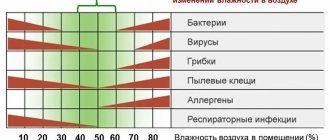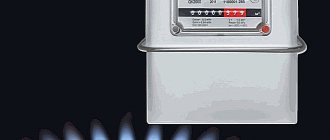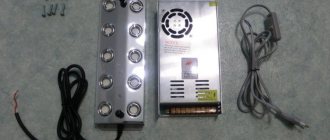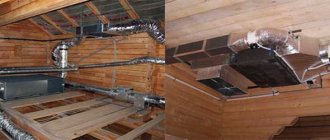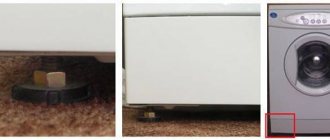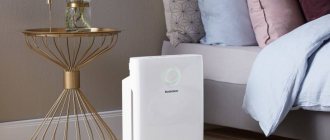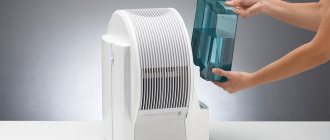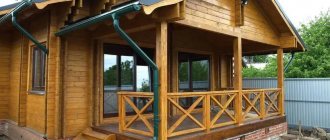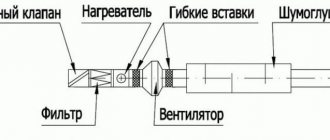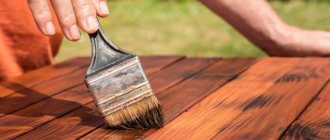2.1. Air Dryer.
2.2. Ventilation.
2.3. Hood.
2.4. Heated towel rail.
2.5. Cleaning ventilation.
3. Solving problems with excess moisture during construction and renovation.
How to dry a house or apartment? How to remove humidity in a room? Excess moisture in the air is a pressing problem. After reading the article of the professional construction portal Stroyka.ru, you can learn about ways to remove moisture from a room, identify and eliminate the causes of humidity in a country house, house, or apartment.
Before wondering how to dry an apartment from dampness, or how to dry a house, it is worth determining the causes of high humidity in the room. A damp room, a room with high air humidity is always a problem. The problem of the appearance of fungus, mold on the walls, in the corners, the problem of swelling of wallpaper, laminate or other floor covering, deformation of furniture and interior items. High humidity also affects health - it noticeably worsens with prolonged stay in such rooms. An increase in humidity in a room causes an unpleasant musty smell and stuffiness in the air. Things and clothes become damp and may also smell unpleasant.
If the apartment has humid air in at least one room, then neighboring rooms may also suffer from increased moisture. And before taking measures to dry the air in the room, you need to find out the reason or reasons for the formation of high humidity in the house.
Excess moisture causes condensation on windows
Humidity standards in a residential area
It is believed that the normal humidity of a living space is about 40-60%. In summer and winter it will change when the heating is turned on and off. A hygrometer will help measure such indicators. To take readings in an apartment, it is better to use an electronic hygrometer.
Both dry and too humid air are dangerous for the human body. And for fans of air conditioners there is a separate reason to worry. It literally pulls water out of the air, drying it out excessively. Even damp laundry or infrequent airing can increase humidity.
Ventilation system
An additional ventilation system will help remove moisture in the basement. It is installed when air exchange is disrupted. There are two types of such ventilation:
- Natural. It uses the so-called. “vents” are openings throughout the room. According to the established norm, their area should correlate with the area of the entire room as 1:400.
- Forced. It is more often used in large rooms. It involves the installation of special equipment. It allows fresh air into the room when necessary.
Forced installation costs a lot.
Why is it worth drying out too humid air?
High humidity leads to the appearance of fungus in the house. Its spores are carried through the air, penetrating the lungs of the inhabitants and guests of the house. This causes rhinitis and asthma. If you live permanently in such unfavorable conditions, you are likely to suffer from chronic rhinitis, migraines, and disturbances in the functioning of the cardiovascular system. But there is no need to panic, in most cases you can successfully reduce the humidity.
Causes of dampness in the room
There are many sources of moisture in the house:
- shower, bath;
- washing clothes, drying them in the apartment;
- aquariums;
- plants;
- groundwater;
- external environment;
- people's breathing.
Among the main reasons for increased humidity are the following:
- Natural ventilation is disrupted. This is the most common reason. It is often associated with replacing windows with plastic ones. Unscrupulous manufacturers may save money and not provide the product with a special ventilation system. Such windows are too sealed and simply do not allow moisture to escape from the home. Condensation appears and mold forms.
- The foundation and walls are poorly insulated from moisture. This is due to a violation of the construction technology of a residential building. With such errors, the foundation transfers moisture to all the walls, and they evaporate it into the room. Such defects are practically irreparable.
- Oddly enough, the third most common cause is salt. It can be added to the foundation in winter to make it strong even in frost. If there is salt in concrete walls, they will be constantly wet. In this case, you need to be patient. After a few years, the walls will finally dry out.
- Frequent rains. At the same time, dampness from the street moves into the house.
- Aquariums, home fountains, waterfalls. They are best placed in rooms with a dry climate.
- Drying clothes in the rooms and kitchen.
- The windows do not face south. A shady location increases humidity.
- Weak central heating in the apartment.
- Leaking roof.
What to do with raw things?
In damp apartments, as a rule, all things in closets and chests of drawers, sofa covers and bed linen are also damp. The bed feels cold and to the touch . In addition, a characteristic unpleasant odor appears. To get rid of it, you will have to wash all things with the addition of vinegar, dry them thoroughly, and then iron them with steam. You can put linen bags with salt or silica gel in cabinets and chests of drawers. But such actions will be effective only if the causes of dampness in the home have been eliminated and the microclimate has been normalized.
Ways to reduce humidity in your home
You can reduce humidity using various means, but first it is important to identify the exact reason for its increase in your home.
- High air humidity may be temporary, for example during cooking. In this case, ventilation will help. You can use available means, for example, turn on the heater. The main thing is to ensure good circulation and oxygen access. The air flow in the room should be especially powerful if moisture begins to condense on the walls. This can be achieved using a regular draft.
- A damp room should be regularly heated with a heating device.
- Poor ceiling condition can also lead to increased dampness. It's not easy to dry it. You can try to plaster again. At the same time, the furniture is taken out so that moisture does not absorb into it.
- PVC windows can significantly limit the access of air into the home and cause dampness in it. When ordering frames, specify the presence of a special ventilation system.
- There are modern means for treating rooms that reduce humidity (for example, “Stop-moisture”). They contain absorber crystals, an absorbent. The moisture ends up in special containers.
So, you can improve humidity indicators yourself:
- Ensure sufficient sunlight penetration into the room. Open curtains regularly. There should be no bulky flowers on the windowsills.
- Ventilate more often (three times a day for half an hour). Ventilation is especially effective in summer and winter, when the air outside is as dry as possible. You can leave the kitchen window open at night.
- Ensure proper ventilation. Check whether the ventilation window is closed and whether the system itself is working.
- If it is very damp, you can turn on a household heater. It will quickly heat and dry the air.
- Drywall and wood are building materials that prevent high humidity. Use them when making repairs.
- Even walls can be covered with plasterboard. Waterproofing plaster will also help solve the problem.
- Insulate the walls outside. This will help, unless of course a flooded basement led to dampness.
- Install a hood in the kitchen. Turn it on every time you cook. Cover kitchen utensils with lids.
- Candles, a hairdryer, and even indoor plants (that don't require frequent watering) will help dry out the room's "atmosphere" a little.
- If dampness has settled in the closet, iron the clothes with a hot iron.
Fans for bathrooms and toilets in the 220pro.ru catalog
Our store offers well-known and popular brands of household bathroom fans:
| Soler & Palau | Blauberg | Fresh | Era | Vents | MMotors JSC |
Let's divide them into groups and get to know each other better.
For a city bathroom or standard-sized bathroom, the most popular type of exhaust fan is a model with a power of up to 100 m3/hour
The catalog contains:
Surface-mounted axial fans
Soler & Palau
| SILENT-100 CZ SILVER DESIGN-3C | SILENT-100 CZ GOLD | SILENT-100 CHZ | SILENT-100 CMZ |
| ECOAIR DESIGN 100 H (with humidity sensor) | ECOAIR DESIGN 100 M (with cord) | ECOAIR DESIGN 100 S (basic model) | EDM 80L |
| SILENT-100 CZ | |||
| Power 65-95 m3, noise 26.5-33 dB, the basic Silent model has a check valve and quiet running bearings (CZ), other models can optionally be added - timer (R), humidity sensor (H), cord switch (M ). | |||
Blauberg
| Aero Still Vintage 100 | Aero Still 100 | Aero Still 100 T | Sileo 100 |
| Power 84, 97 cu.m. meters, noise level 25 dB, additional options include cord switch and timer. | |||
Era
| FAVORITE 4 | COMFORT 4 | DISC 4 | E 100 S |
| OPTIMA 4 | |||
| Power 80-90-95-97 m3, noise level 35 dB. Models with additional options have additional coding 01 - power cable and switch, 02 - traction motor, C - check valve. | |||
MMotors JSC
| MM-100 S (basic) | MM-100 S OK (with check valve) |
Power 60 cubic meters, noise 25 dB, ultra-thin models with a thickness of 4 cm.
Duct axial fans
For installation in a round air duct, duct models are used. Among low-power ones we offer Bulgarian MMotors JSC
| BO 90 | BO 90T |
Power 50 m3, noise 36 dB, operating temperature +100-150°C.
Centrifugal fans
Due to the design and the creation of additional traction, such hoods, even at low power, are more efficient than axial ones. They cost more, so they are taken less often. Although the “usefulness” of a centrifugal fan quickly pays for its cost.
The main operating mode is minimum speed and minimum energy consumption. The hood works great for a long time in the background for routine cleaning. When the humidity rises, the maximum mode is switched on and the air in the bathroom is quickly replaced.
Among the centrifugal ones we offer a fan from the company Era
| SOLO 4C era |
Three-speed, capacity 42/64/100 m3, noise level 25.8-30 dB, equipped with a check valve and filter. Suitable for wall/ceiling installation and vent mounting.
In new houses, with large apartments, townhouses and cottages, the bathrooms are more spacious and for cleaning they are equipped with hoods with a capacity of 100 to 400 m3 per hour
The 220pro.ru catalog presents the following models:
Axial fans for wall or ceiling
Blauberg
| Aero Chrome 100 | Aero Still Vintage 125 | Aero Still Vintage 150 | Aero Still 125 |
| Aero Still 150 | Deco 100 (ceiling) |
Power 102, 154, 254 m3, noise level 31-33-38 dB, all models have a check valve, additional options are indicated by letter markings, T - with a timer, ST - with a cord and a timer. Ceiling ones have a power of 105 cubic meters and a noise level of 37 dB.
Soler & Polau
| SILENT-200 CRZ (with timer) | SILENT-300 CHZ (with timer and humidity sensor) | EDM 200C | Decor 200С |
Capacity 175, 180, 280, 320 m3, noise level in the SILENT series 35-36 dB, in other models 42-47 dB.
Era
| ERA 5S | ERA 6C (with check valve) | SLIM 5 | SLIM 6-02 (with pull cord switch) |
Capacity 140-183, 250-290 m3, noise level 30-33, 36-38 dB.
FRESH
| PAX Norte (quietest model at 17 dB) | INTELLIGENT White | INTELLIGENT Black |
Capacity 110-132m3, noise 17-22dB. New generation fans. Equipped with a smart control system, speed switching mode, and sensors. They can work automatically using a built-in program or run in the selected mode via a smartphone or computer.
Duct hoods
Blauberg
| Tubo 100 | Tubo 125 | Tubo 150 | Turbo 100 |
| power 137, 245, 361 m3, noise level 38-39-40 dB. | two-speed, power 170/220 m3 per hour, noise level - 27/32 dB, wall or ceiling mounting. | ||
Soler & Palau
| TDM100 | TDM200 | TDM300 | Silentub 100 |
| power 110-200-300 cubic meters, noise 40-45 dB, suitable for short round air ducts and for installation in a ventilation hole in the wall. | power 100 cubic meters, noise 37.5 dB, for short round channels and for wall mounting. | ||
Era
| PRO 4 | PRO 5 | PRO 6 |
productivity 115, 195, 320 cubic meters per hour, noise from 32 to 36 decibels, mounted on a wall or ceiling, both exhaust and air supply work.
Vents
| iFan D100/125 |
intelligent, maximum power 106 m3, in quiet mode - 72. noise level 31 dB (22 in quiet). Basic humidity control, timer, additional speed control - motion sensor operation. Suitable for non-stop ventilation at a capacity of up to 40 m3/hour.
Dehumidifier: operating principles
We described in detail how to dehumidify the air in an apartment without a dehumidifier, but in some cases you cannot do without this device. A dehumidifier is used if the humidity in the apartment is too high, and other methods of combating it have not helped.
- Its operation is based on the absorption of air through the evaporator. The temperature inside the device is lower than in the room. Moisture condenses on its walls and flows into the container. In this case, the dried stream flows back into the room.
- So, this device will help you quickly dry out too humid air in your apartment. The desiccant can be portable or stationary. The latter have greater productivity. They are mounted on the wall, which saves room space. Portable ones have smaller dimensions, therefore their power is lower. When purchasing, you should clarify what the power of the device is. Choose a device with maximum power.
- You can try to assemble a dehumidifier yourself. To do this, watch the video after the article.
We have described in detail how to choose a dehumidifier for your home in this article.
Installation process
Installation
In order to install the fan as quickly as possible, you should prepare the place in advance during repairs, namely, install the power supply and make an exhaust hole of the required size. If all this was done in advance, then the installation process will take even the most inexperienced person no more than half an hour.
Installation proceeds as follows:
- First, the fan is prepared: remove the grille;
- Apply construction adhesive to the side that will later be joined to the wall;
- We attach the fan to the prepared exhaust hole, hold it pressed for 5 minutes so that the glue sets;
- We connect it to the power supply, this stage may be the third, depending on the design of the equipment;
- We fix the fan grille in place.
Preventing dampness in the home
For prevention, it is worth remembering the following tips:
- After washing, showering, taking a bath, ventilate the bathroom.
- You should not dry clothes in the apartment. There is a balcony for this. Modern washing machines also have a drying function.
- Install plastic windows with ventilation.
- Avoid using an aquarium, fountain or indoor waterfall.
- Among indoor plants, choose succulents and cacti. They do not need frequent watering.
So, high humidity in apartments is a very common problem. Follow simple prevention tips and you will not encounter this extremely unpleasant phenomenon.
